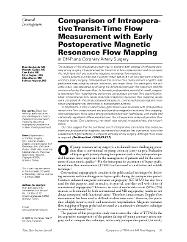| dc.contributor.author | Sanisoğlu, İlhan | |
| dc.contributor.author | Güden, Mustafa | |
| dc.contributor.author | BalcI, Cem | |
| dc.contributor.author | SaĞbaŞ, Ertan | |
| dc.contributor.author | Duran, Cihan | |
| dc.contributor.author | AkpInar, Belhhan | |
| dc.date.accessioned | 2019-06-27T08:00:59Z | |
| dc.date.available | 2019-06-27T08:00:59Z | |
| dc.date.issued | 2003 | |
| dc.identifier.issn | 0730-2347 | en_US |
| dc.identifier.uri | https://hdl.handle.net/20.500.12469/197 | |
| dc.identifier.uri | https://www.ncbi.nlm.nih.gov/pmc/articles/PMC152832/ | |
| dc.description.abstract | The purpose of this prospective study was to evaluate graft patency of off-pump coronary artery surgery intraoperatively by transit-time flow measurement and to compare this technique with postoperative magnetic resonance flow mapping. Twenty patients (13 men and 7 women | en_US] |
| dc.description.abstract | mean age 67.9 +/- 76 yr) underwent off-pump coronary artery surgery. Intraoperative transit-time flow measurement of grafts was performed measuring maximum minimum and mean flows. For each graft the pulsatile index was calculated by dividing the difference between the maximum and the minimum flow by the mean flow. In the early postoperative period (1st week) magnetic resonance flow mapping was performed using phase contrast flow quantification. Mean intraoperative flow values and mean magnetic resonance flow mapping values were compared. At the same postoperative session contrast-enhanced magnetic resonance angiography was performed to evaluate graft patency. In 20 patients a total of 49 coronary graft flows were assessed with intraoperative transit-time flow measurement and postoperative magnetic resonance flow mapping. Upon comparison there was a strong correlation between techniques with stable and statistically significant differences between the intraoperative and postoperative flow mapping values. One saphenous vein graft was revised intraoperatively due to graft failure. Our data suggest that the combined use of intraoperative transit-time flow measurement and postoperative magnetic resonance flow analysis has a potential role in the assessment of graft patency in off-pump coronary artery surgery although more study is required. | en_US] |
| dc.language.iso | eng | en_US |
| dc.publisher | Texas Heart Inst. | en_US |
| dc.rights | info:eu-repo/semantics/openAccess | en_US |
| dc.subject | Blood flow velocity | en_US |
| dc.subject | Graft occlusion | en_US |
| dc.subject | Vascular/diagnosis | en_US |
| dc.subject | Hemorheology/instrumentation | en_US |
| dc.subject | Magnetic resonance angiography | en_US |
| dc.subject | Prospective studies | en_US |
| dc.subject | Rheology/methods | en_US |
| dc.title | Comparison of intraoperative transit-time flow measurement with early postoperative magnetic resonance flow mapping - in off-pump coronary artery surgery | en_US |
| dc.type | article | en_US |
| dc.identifier.startpage | 31 | en_US |
| dc.identifier.endpage | 37 | |
| dc.relation.journal | Texas Heart Institute Journal | en_US |
| dc.identifier.issue | 1 | |
| dc.identifier.volume | 30 | en_US |
| dc.identifier.wos | WOS:000181409700007 | en_US |
| dc.relation.publicationcategory | Makale - Uluslararası Hakemli Dergi - Kurum Öğretim Elemanı | en_US |
| dc.identifier.pmid | 12638668 | en_US |
















